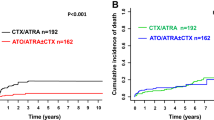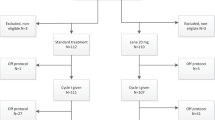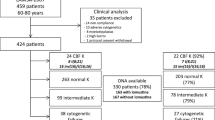Abstract
Treatment outcome in older patients with acute promyelocytic leukemia (APL) is lower compared with younger patients, mainly because of a higher induction death rate and postremission non-relapse mortality (NRM). This prompted us to design a risk- and age-adapted protocol (Programa Español de Tratamientos en Hematología (PETHEMA)/HOVON LPA2005), with dose reduction of consolidation chemotherapy. Patients aged ⩾60 years reported to the PETHEMA registry and were treated with all-trans retinoic acid (ATRA) plus anthracycline-based regimens according to three consecutive PETHEMA trials that were included. We compared the long-term outcomes of the LPA2005 trial with the preceding PETHEMA trials using non-age-adapted schedules (LPA96&LPA99). From 1996 to 2012, 389 older patients were registered, of whom 268 patients (69%) were eligible. Causes of ineligibility were secondary APL (19%), and unfit for chemotherapy (11%). Median age was 67 years, without relevant differences between LPA2005 and LPA96&LPA99 cohorts. Overall, 216 patients (81%) achieved complete remission with no differences between trials. The 5-year NRM, cumulative incidence of relapse, disease-free survival and overall survival in the LPA2005 vs the LPA96&99 were 5 vs 18% (P=0.15), 7 vs 12% (P=0.23), 87 vs 69% (P=0.04) and 74 vs 60% (P=0.06). A less intensive front-line regimen with ATRA and anthracycline monochemotherapy resulted in improved outcomes in older APL patients.
This is a preview of subscription content, access via your institution
Access options
Subscribe to this journal
Receive 12 print issues and online access
$259.00 per year
only $21.58 per issue
Buy this article
- Purchase on Springer Link
- Instant access to full article PDF
Prices may be subject to local taxes which are calculated during checkout



Similar content being viewed by others
References
Lehmann S, Ravn A, Carlsson L, Antunovic P, Deneberg S, Möllgård L et al. Continuing high early death rate in acute promyelocytic leukemia: a population-based report from the Swedish Adult Acute Leukemia Registry. Leukemia 2011; 25: 1128–1134.
Chen Y, Kantarjian H, Wang H, Cortes J, Ravandi F . Acute promyelocytic leukemia: a population-based study on incidence and survival in the United States,1975–2008. Cancer 2012; 118: 5811–5818.
Sanz MA, Grimwade D, Tallman MS, Lowenberg B, Fenaux P, Estey EH et al. Management of acute promyelocytic leukemia: recommendations from an expert panel on behalf of the European LeukemiaNet. Blood 2009; 113: 1875–1891.
Sanz MA, Vellenga E, Rayón C, Díaz-Mediavilla J, Rivas C, Amutio E et al. All-trans retinoic acid and anthracycline monochemotherapy for the treatment of elderly patients with acute promyelocytic leukemia. Blood 2004; 104: 3490–3493.
Mandelli F, Latagliata R, Avvisati G, Fazi P, Rodeghiero F, Leoni F et al. Treatment of elderly patients (> or =60 years) with newly diagnosed acute promyelocytic leukemia. Results of the Italian multicenter group GIMEMA with ATRA and idarubicin (AIDA) protocols. Leukemia 2003; 17: 1085–1090.
Ades L, Chevret S, de Botton S, Thomas X, Dombret H, Beve B et al. Outcome of acute promyelocytic leukemia treated with all trans retinoic acid and chemotherapy in elderly patients: the European group experience. Leukemia 2004; 19: 230–233.
Ades L, Guerci A, Raffoux E, Sanz M, Chevallier P, Lapusan S et al. Very long-term outcome of acute promyelocytic leukemia after treatment with all-trans retinoic acid and chemotherapy: the European APL Group experience. Blood 2010; 115: 1690–1696.
Latagliata R, Breccia M, Fazi P, Vignetti M, Di Raimondo F, Sborgia M et al. GIMEMA AIDA 0493 amended protocol for elderly patients with acute promyelocytic leukaemia. Long-term results and prognostic factors. Br J Haematol 2011; 154: 564–568.
Ono T, Takeshita A, Kishimoto Y, Kiyoi H, Okada M, Yamauchi T et al. Long-term outcome and prognostic factors of elderly patients with acute promyelocytic leukemia. Cancer Sci 2012; 103: 1974–1978.
Lengfelder E, Hanfstein B, Haferlach C, Braess J, Krug U, Spiekermann K et al. Outcome of elderly patients with acute promyelocytic leukemia: results of the German Acute Myeloid Leukemia Cooperative Group. Ann Hematol 2013; 92: 41–52.
Sanz MA, Montesinos P, Rayón C, Holowiecka A, de la Serna J, Milone G et al. Risk-adapted treatment of acute promyelocytic leukemia based on all-trans retinoic acid and anthracycline with addition of cytarabine in consolidation therapy for high-risk patients: further improvements in treatment outcome. Blood 2010; 115: 5137–5146.
Estey E, Garcia-Manero G, Ferrajoli A, Faderl S, Verstovsek S, Jones D et al. Use of all-trans retinoic acid plus arsenic trioxide as an alternative to chemotherapy in untreated acute promyelocytic leukemia. Blood 2006; 107: 3469–3473.
Burnett AK, Russell NH, Hills RK, Bowen D, Kell J, Knapper S et al. Arsenic trioxide and all-trans retinoic acid treatment for acute promyelocytic leukaemia in all risk groups (AML17): results of a randomised, controlled, phase 3 trial. Lancet Oncol 2015; 16: 1295–1305.
Sanz MA, Martín G, Rayon C, Esteve J, González M, Díaz-Mediavilla J et al. A modified AIDA protocol with anthracycline-based consolidation results in high antileukemic efficacy and reduced toxicity in newly diagnosed PML/RARalpha-positive acute promyelocytic leukemia. PETHEMA group. Blood 1999; 94: 3015–3021.
Sanz MA, Martín G, González M, León A, Rayón C, Rivas C et al. Risk-adapted treatment of acute promyelocytic leukemia with all-trans-retinoic acid and anthracycline monochemotherapy: a multicenter study by the PETHEMA group. Blood 2004; 103: 1237–1243.
Sanz MA, Montesinos P, Vellenga E, Rayón C, de la Serna J, Parody R et al. Risk-adapted treatment of acute promyelocytic leukemia with all-trans retinoic acid and anthracycline monochemotherapy: long-term outcome of the LPA 99 multicenter study by the PETHEMA Group. Blood 2008; 112: 3130–3134.
Montesinos P, Rayón C, Vellenga E, Brunet S, González J, González M et al. Clinical significance of CD56 expression in patients with acute promyelocytic leukemia treated with all-trans retinoic acid and anthracycline-based regimens. Blood 2011; 117: 1799–1805.
De la Serna J, Montesinos P, Vellenga E, Rayón C, Parody R, León A et al. Causes and prognostic factors of remission induction failure in patients with acute promyelocytic leukemia treated with all-trans retinoic acid and idarubicin. Blood 2008; 111: 3395–3402.
Montesinos P, Bergua JM, Vellenga E, Rayón C, Parody R, de la Serna J et al. Differentiation syndrome in patients with acute promyelocytic leukemia treated with all-trans retinoic acid and anthracycline chemotherapy: characteristics, outcome, and prognostic factors. Blood 2009; 113: 775–783.
Cheson BD, Bennett JM, Kopecky KJ, Büchner T, Willman CL, Estey EH et al. Revised recommendations of the International Working Group for Diagnosis, Standardization of Response Criteria, Treatment Outcomes, and Reporting Standards for Therapeutic Trials in Acute Myeloid Leukemia. J Clin Oncol 2003; 21: 4642–4649.
Sanz MA, Lo-Coco F, Martín G, Avvisati G, Rayón C, Barbui T et al. Definition of relapse risk and role of nonanthracycline drugs for consolidation in patients with acute promyelocytic leukemia: a joint study of the PETHEMA and GIMEMA cooperative groups. Blood 2000; 96: 1247–1253.
Frankel SR, Eardley A, Lauwers G, Weiss M, Warrell RP Jr . The 'retinoic acid syndrome' in acute promyelocytic leukemia. Ann Intern Med 1992; 117: 292–296.
Kaplan EL, Meier P . Nonparametric estimation from incomplete observations. J Am Stat Assoc 1958; 53: 457–481.
Mantel N . Evaluation of survival data and two new rank order statistics arising in its consideration. Cancer Chemother Rep 1966; 50: 163–170.
Gray RJ . A class of K-sample tests for comparing the cumulative incidence of a competing risk. Ann Statist 1988; 16: 1141–1154.
Pepe MS, Mori M . Kaplan–Meier, marginal or conditional probability curves in summarizing competing risks failure time data? Stat Med 1993; 12: 737–751.
Gooley TA, Leisenring W, Crowley J, Storer BE . Estimation of failure probabilities in the presence of competing risks: new representations of old estimators. Stat Med 1999; 18: 695–706.
Burnett AK, Grimwade D, Solomon E, Wheatley K, Goldstone AH . Presenting white blood cell count and kinetics of molecular remission predict prognosis in acute promyelocytic leukemia treated with all-trans retinoic acid: result of the Randomized MRC Trial. Blood 1999; 93: 4131–4143.
Fenaux P, Chastang C, Chevret S, Sanz M, Dombret H, Archimbaud E et al. A randomized comparison of all transretinoic acid (ATRA) followed by chemotherapy and ATRA plus chemotherapy and the role of maintenance therapy in newly diagnosed acute promyelocytic leukemia. The European APL Group. Blood 1999; 94: 1192–1200.
Zhang Y, Zhang Z, Li J, Li L, Han X, Han L et al. Long-term efficacy and safety of arsenic trioxide for first-line treatment of elderly patients with newly diagnosed acute promyelocytic leukemia. Cancer 2013; 119: 115–125.
Acknowledgements
We thank María D García, Carlos Pastorini and Mar Benlloch for data collection and management. This work was partially financed with FEDER funds (CIBERONC (CB16/12/00284)). This study was presented in the 21st Congress of the European-Hematology-Association.
Author contributions
DM-C, PM and MAS conceived the study, analyzed and interpreted the data; DM-C, PM and MAS wrote the paper; DM-C and PM performed the statistical analyses; EV, TB, OS, AH, SB, PF, CB, J-MR, MP-E, JS, JE, VR, JG-C, LE, MEA, MA, JA, SN and BL included data of patients treated in their institutions, reviewed the manuscript and contributed to the final draft.
Author information
Authors and Affiliations
Consortia
Corresponding author
Ethics declarations
Competing interests
The authors declare no conflict of interest.
Additional information
This study was presented in the 21st Congress of the European-Hematology-Association.
Rights and permissions
About this article
Cite this article
Martínez-Cuadrón, D., Montesinos, P., Vellenga, E. et al. Long-term outcome of older patients with newly diagnosed de novo acute promyelocytic leukemia treated with ATRA plus anthracycline-based therapy. Leukemia 32, 21–29 (2018). https://doi.org/10.1038/leu.2017.178
Received:
Revised:
Accepted:
Published:
Issue Date:
DOI: https://doi.org/10.1038/leu.2017.178
This article is cited by
-
Comparative analysis of causes and predictors of early death in elderly and young patients with acute promyelocytic leukemia treated with arsenic trioxide
Journal of Cancer Research and Clinical Oncology (2020)
-
Outcome of older (≥70 years) APL patients frontline treated with or without arsenic trioxide—an International Collaborative Study
Leukemia (2020)
-
Predictors of early death, serious hemorrhage, and differentiation syndrome in Japanese patients with acute promyelocytic leukemia
Annals of Hematology (2020)
-
Management of patients with acute promyelocytic leukemia
Leukemia (2018)



